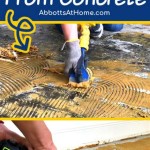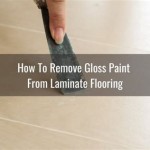How To Remove Double Sided Carpet Tape From Wood Floors
Double-sided carpet tape is a common adhesive used to secure rugs and carpets to wood floors, preventing slippage and potential accidents. However, removing this tape can be a challenging endeavor, as the adhesive is designed to be strong and durable. Improper removal techniques can lead to damage to the wood floor's finish, leaving behind unsightly residue, or even causing structural issues. This article provides a comprehensive guide on how to safely and effectively remove double-sided carpet tape from wood floors, minimizing the risk of damage and restoring the floor's original appearance.
Before initiating the removal process, it is crucial to identify the type of wood floor finish. Wood floors are typically finished with either a surface finish, such as polyurethane, or a penetrating finish, such as oil-based sealants. Surface finishes create a protective layer on top of the wood, while penetrating finishes soak into the wood fibers. Understanding the type of finish will inform the choice of removal techniques and cleaning agents, ensuring compatibility and preventing adverse reactions. Testing a small, inconspicuous area first is always recommended to assess the impact of any chosen method.
Preparation is key to a successful carpet tape removal. Gather the necessary tools and materials, which may include a plastic scraper, a heat gun or hairdryer, mineral spirits or adhesive remover, soft cloths, and a vacuum cleaner. Protect the surrounding area by covering it with drop cloths or plastic sheeting to prevent accidental spills or damage. Adequate ventilation is also essential, especially when using chemical solvents. Open windows and doors to ensure proper airflow and wear appropriate protective gear, such as gloves and eye protection, to safeguard against potential irritants.
Applying Heat to Soften the Adhesive
Heat can be a valuable tool in softening the adhesive bond of carpet tape, making it easier to peel away from the wood floor. A heat gun or hairdryer can be used to apply focused heat to the tape residue. It is crucial to maintain a safe distance between the heat source and the floor to avoid scorching or damaging the wood finish. Begin by holding the heat gun or hairdryer several inches away from the tape and moving it back and forth in a sweeping motion. Avoid concentrating the heat on one spot for an extended period.
The goal is to warm the adhesive, not melt it completely. As the tape heats up, the adhesive should become more pliable and less likely to tear the wood finish. After a few minutes of heating, gently try to lift a corner of the tape using a plastic scraper. If the tape comes up easily, continue heating and scraping along the length of the tape. If the tape is still stubbornly adhered, apply more heat and try again. Patience is essential to avoid forcing the tape and potentially damaging the floor.
For particularly stubborn adhesive residue, a combination of heat and a plastic scraper may be necessary. While applying heat, use the scraper to gently lift and peel away the tape. Be careful not to apply too much pressure, as this could scratch or gouge the wood floor. The scraper should be held at a low angle to minimize the risk of damage. Work slowly and methodically, heating and scraping small sections of the tape at a time. If the tape starts to tear or leave behind residue, reapply heat and try again.
Using Chemical Solvents to Dissolve Adhesive Residue
In cases where heat alone is insufficient to remove the carpet tape residue, chemical solvents may be necessary. Mineral spirits, adhesive removers specifically designed for removing tape residue, or even certain citrus-based cleaners can be effective in dissolving the adhesive. However, it is crucial to choose a solvent that is safe for use on wood floors and will not damage the finish. Always test the solvent on a small, inconspicuous area first to ensure compatibility and prevent adverse reactions.
Apply the chosen solvent to the adhesive residue using a soft cloth. Avoid pouring the solvent directly onto the floor, as this could saturate the wood and cause warping or staining. Instead, dampen the cloth with the solvent and gently dab or wipe the residue. Allow the solvent to sit for a few minutes, giving it time to penetrate and break down the adhesive. Follow the manufacturer's instructions regarding dwell time and safety precautions.
After the solvent has had sufficient time to work, use a plastic scraper to gently remove the softened adhesive. Again, avoid applying too much pressure, and hold the scraper at a low angle to minimize the risk of scratching or gouging the floor. Wipe away the dissolved adhesive with a clean cloth, and repeat the process as necessary until all of the residue is removed. Be sure to properly ventilate the area while using solvents, and wear appropriate protective gear.
Once the adhesive residue is removed, it is essential to clean the area thoroughly with a mild soap and water solution to remove any remaining solvent. Use a clean, damp cloth to wipe the floor, and then dry it immediately with another clean cloth. Avoid using excessive water, as this could damage the wood floor. A gentle floor cleaner specifically designed for wood floors can also be used, following the manufacturer's instructions.
Addressing Specific Types of Adhesive Residue
Different types of carpet tape utilize different adhesive formulations, and the effectiveness of various removal techniques can vary accordingly. Some tapes leave behind a thick, gummy residue, while others leave a thin, sticky film. Identifying the type of residue can help to tailor the removal approach for optimal results. For example, gummy residues may respond better to heat and scraping, while sticky films may require more aggressive solvent treatment.
For thick, gummy residues, consider using a combination of heat and a plastic scraper. Apply heat to soften the residue, and then use the scraper to peel away as much of the gummy material as possible. Follow up with a solvent treatment to remove any remaining residue. Stubborn gummy residues may require multiple applications of heat and solvent. Mineral spirits or adhesive removers specifically designed for removing gummy adhesives can be particularly effective.
For thin, sticky films, a solvent treatment may be the most effective approach. Apply the solvent to the residue, allow it to dwell for the recommended time, and then wipe away the dissolved adhesive with a clean cloth. Repeat the process as necessary until all of the residue is removed. Citrus-based cleaners can be effective for removing sticky films, as they contain natural solvents that dissolve adhesive residue. However, always test the cleaner on a small, inconspicuous area first to ensure compatibility with the wood floor finish.
In some cases, the carpet tape may have been applied for an extended period, causing the adhesive to become deeply embedded in the wood floor. In these situations, more aggressive removal techniques may be necessary. A steam cleaner can be used to loosen the adhesive, or a specialized adhesive remover can be applied to the residue. Always follow the manufacturer's instructions carefully when using these methods, and take precautions to protect the wood floor from damage.
After removing the carpet tape and any remaining adhesive residue, it is essential to inspect the wood floor for any damage. Scratches, gouges, or discoloration may require repair or refinishing. Small scratches can often be buffed out with a fine-grit sandpaper, while deeper scratches may require filling with wood filler. Discoloration can be addressed with wood stain or touch-up paint. If the damage is extensive, it may be necessary to refinish the entire floor.
Preventing future carpet tape residue problems is also important. Consider using rug pads instead of carpet tape to secure rugs and carpets to wood floors. Rug pads provide cushioning and prevent slippage without the need for adhesive. If carpet tape is necessary, choose a low-tack tape that is specifically designed for use on wood floors. These tapes are less likely to leave behind residue and are easier to remove. Regularly inspect the tape and replace it as needed to prevent the adhesive from becoming deeply embedded in the wood.
By following these steps, removing double-sided carpet tape from wood floors can be achieved safely and effectively, minimizing the risk of damage and restoring the floor's original beauty. Patience, careful technique, and the appropriate tools and materials are essential for success. Always test any cleaning agents or solvents on a small, inconspicuous area first, and take precautions to protect the surrounding area from spills or damage. With proper care and attention, the wood floor can be restored to its original condition.

How To Remove Double Sided Carpet Tape Hometalk

Easy Ways To Get Rid Of Carpet Tape On Wooden Floors Or Stairs Floor Sanding

How To Remove Double Sided Carpet Tape From A Wood Floor

Removing Carpet Tape From Hardwood Floors Or Stairs

How To Remove Double Sided Carpet Tape From A Wood Floor

Removing Carpet Tape From Hardwood Floors Or Stairs

The Best Way To Remove Tape Residue From Hardwood Flooring Between Naps On Porch

The Best Way To Remove Tape Residue From Hardwood Flooring Between Naps On Porch

The Best Way To Remove Tape Residue From Hardwood Flooring Between Naps On Porch

Double Sided Carpet Tape On Hardwood Floor Test Carpettape Doublesidedtape Rugs Ruggable
See Also







